1994 PONTIAC GRAND-AM tire pressure
[x] Cancel search: tire pressurePage 125 of 274
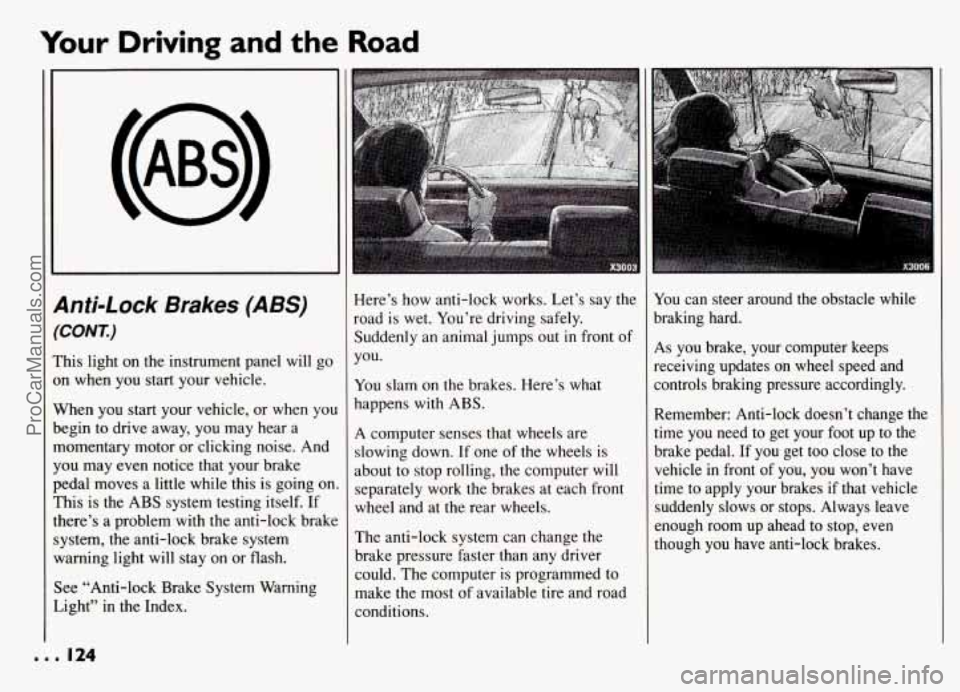
Your Driving and the Road
anti-Lock Brakes (ABS)
‘CONT.)
’his light on the instrument panel will go
In when you start your vehicle.
Nhen you start your vehicle, or when yo^
begin to drive away, you may hear a
nomentary motor or clicking noise. And
‘ou may even notice that your brake
edal moves a little while this
is going on
rhis is the ABS system testing itself.
If
here’s a problem with the anti-lock brakc
ystem, the anti-lock brake system
Yarning light will stay on or flash.
iee “Anti-lock Brake System Warning
ight” in the Index.
Here’s how anti-lock works. Let’s say the
road is wet. You’re driving safely.
Suddenly an animal jumps out in front of
you.
You slam on the brakes. Here’s what
happens with ABS.
A computer senses that wheels are
slowing down. If one of the wheels is
about to stop rolling, the computer will
separately work the brakes at each front
wheel and at the rear wheels.
The anti-lock system can change the
brake pressure faster than any driver
could. The computer is programmed to
make the most of available tire and road
conditions.
You can steer around the obstacle while
braking hard.
As you brake, your computer keeps
receiving updates
on wheel speed and
controls braking pressure accordingly.
Remember: Anti-lock doesn’t change the
time you need to get your foot up to the
brake pedal.
If you get too close to the
vehicle in front of you, you won’t have
time to apply your brakes
if that vehicle
suddenly slows
or stops. Always leave
enough room
up ahead to stop, even
though you have anti-lock brakes.
... 124
ProCarManuals.com
Page 132 of 274

Driving too fast through large water
puddles or even going through some car
washes
can cause problems, too. The
water may affect your brakes. Try to
avoid puddles. But if you can’t, try to
slow down before you hit them.
I Hydroplaning
Hydroplaning is dangerous. So much
water can build up under your tires that
they can actually ride on the water. This
can happen if the road is wet enough and
you’re going fast enough. When your
vehicle is hydroplaning, it has little or
no
contact with the road.
Hydroplaning doesn’t happen often. But it
can if your tires haven’t much tread or if
the pressure in one or more is low. It can
happen if a lot of water is standing on the
road. If you can see reflections from trees,
telephone poles, or other vehicles, and
raindrops “dimple” the water’s surface,
there could be hydroplaning.
Hydroplaning usually happens at higher
speeds. There just isn’t a hard and fast
rule about hydroplaning. The best advice
is to slow down when it is raining.
Some Other Rainy
Weather
Tips
0
e
0
Turn on your low-beam headlights --
not just your parking lights -- to help
make you more visible to others.
Besides slowing down, allow some
extra following distance. And be
especially careful when you ‘pass
another vehicle. Allow yourself more
clear room ahead, and be prepared to
have your view restricted by-road
spray.
Have good tires with proper tread
depth. (See “Tires” in the Index.)
131 ...
ProCarManuals.com
Page 134 of 274

At the entrance there is usually a ramp
that leads to the freeway. If you have a
clear view of the freeway as you drive
along
the entrance ramp, you should
begin to check traffic. Try to determine
where you expect
to blend with the flow.
Try to merge into the gap at close
to the
prevailing speed. Switch on your turn signal, check your mirrors and glance
over your shoulder as often as necessary.
Try to blend smoothly with the traffic
flow.
Once you are on the freeway, adjust your
speed to the posted limit or to the
prevailing rate if it’s slower. Stay in the
right lane unless you want to pass.
Before changing lanes, check your
mirrors. Then use your turn signal.
Just before you leave the lane, glance
quickly over your shoulder to make sure
there isn’t another vehicle in your “blind”
spot.
Once you are moving on the freeway,
make certain you allow a reasonable following distance. Expect to move
slightly slower at night.
When you want to leave the freeway,
move to the proper lane well
in advance.
If you-miss your exit do not; under any
circumstances, stop and back
up. Drive on
to the next exit.
The exit ramp can be curved, sometimes
quite sharply.
The exit speed is usually posted.
Reduce your speed according to your
speedometer, not to your sense of motion.
After driving for any distance at higher
speeds, you may tend to think you are
going slower than you actually are.
Before Leaving on a
Long Trip
Make sure you’re ready. Try to be well
rested. If
you must start when you’re not
fresh
-- such as after a day’s work --
don’t plan to make too many miles that
first part of the journey. Wear comfortable
clothing and shoes you can easily drive
in.
Is your vehicle ready for a long trip? If
you keep it serviced and maintained, it’s
ready to go. If it needs service, have it
done before starting out. .Of course, you’ll
find experienced and able service experts
in Pontiac dealerships all across North
America. They’ll be ready and willing to
help if you need it.
Here are some things you can check
before a trip:
0
0
0
0
0
0
0
Windshield Washer Fluid: Is the
reservoir full? Are all windows clean
inside and outside?
Wiper Blades: Are they in good
shape?
Fuel, Engine Oil. Other Fluids: Have
you checked all levels?
Lights:’
Are they all working? Are the
lenses clean?
Tires: They are vitally important to a
safe, trouble-free trip. Is the tread
good enough for long-distance
driving?
Are the tires all inflated to
the recommended pressure?
Weather Forecasts: What’s the
weather outlook along your route?
Should you delay your trip a short
time to avoid a major storm system?
Maps: Do you have up-to-date maps?
133...
ProCarManuals.com
Page 162 of 274
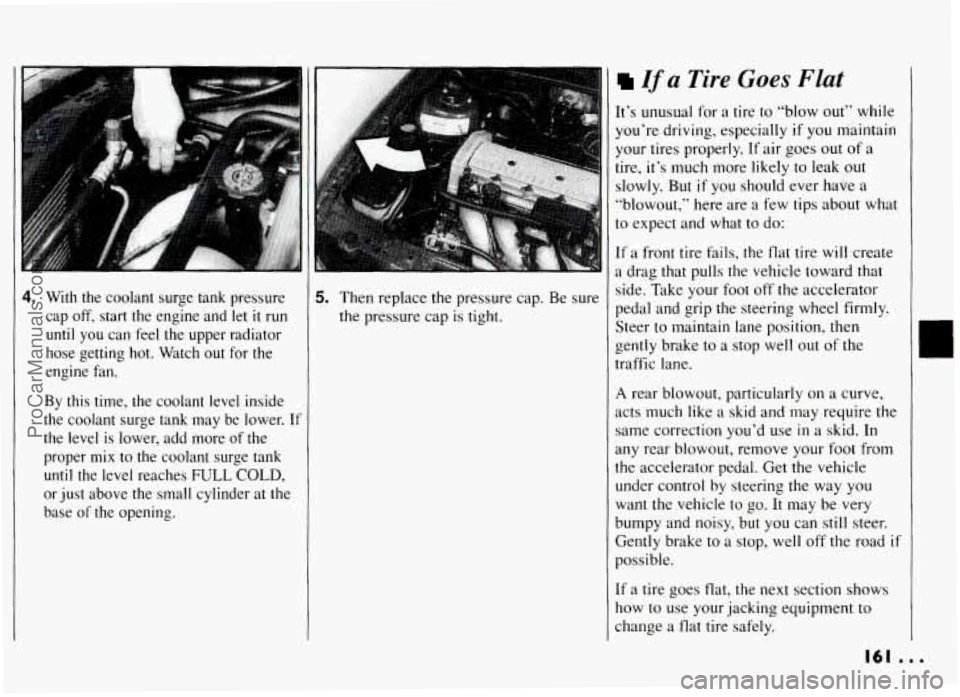
7
4. With the coolant surge tank pressure
cap off, start the engine and let
it run
until you can feel the upper radiator
hose getting hot. Watch out for the
engine fan.
By this time, the coolant level inside
the coolant surge tank may be lower. If
the level is lower, add more
of the
proper
mix to the coolant surge tank
until the level reaches FULL COLD,
or just above the small cylinder at the
base
of the opening.
I
5. Then replace the pressure cap. Be sure
the pressure cap is tight.
If a Tire Goes Flat
It’s unusual for a tire to “blow out” while
you’re driving, especially
if you maintain
your tires properly. If air goes out
of a
tire, it’s much more likely to leak out
slowly. But if you should ever have a
“blowout,” here are
a few tips about what
to expect and what to do:
If a front tire fails, the flat tire will create
a drag that pulls the vehicle toward that
side. Take your foot off the accelerator
pedal and grip
the steering wheel firmly.
Steer to maintain lane position, then
gently brake to
a stop well out of the
traffic lane.
A rear blowout, particularly on a curve,
acts much like a skid and may require
the
same correction you’d use in a skid. In
my rear blowout, remove your foot from
the accelerator pedal. Get the vehicle
under control by steering the way you
want the vehicle to go. It may be very
wmpy and noisy, but you can still steer.
Sently brake to a stop, well off the road if
Jossible.
[fa tire goes flat, the next section shows
low to use your jacking equipment to
:hange a
flat tire safely.
161 ...
ProCarManuals.com
Page 168 of 274
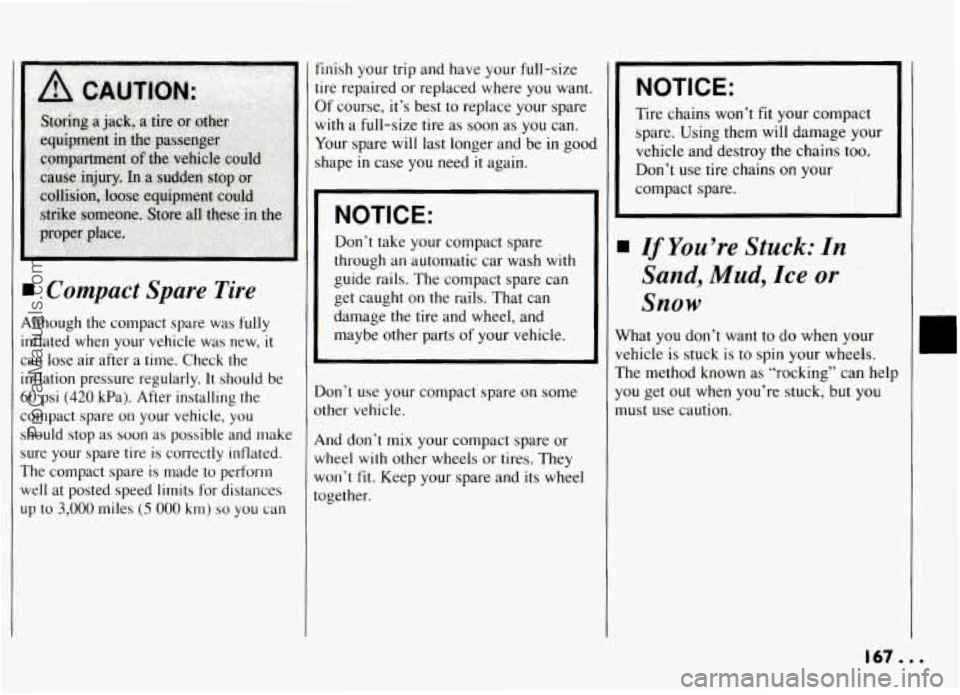
P
t
I
A
ir:
in
Ci
SL
W
I Compact Spare Tire
hhough the compact spare was fully
lflated when your vehicle was new, it
in lose air after a time. Check the
iflation pressure regularly. It should be
3 psi (420 kPa). After installing the
Impact spare on your vehicle, you lould stop as soon as possible and make
ire your spare tire is correctly inflated.
he compact spare is made to perform
ell at posted speed limits for distances
J to 3,000 miles (5 000 km) so you can
finish your trip and have your full-size
tire repaired or replaced where you want.
Of course, it’s best to replace your spare
with a full-size tire as soon as you can.
Your spare will last longer and be
in good
shape
in case you need it again.
NOTICE:
Don’t take your compact spare
through an automatic car wash
with
guide rails. The compact spare can
get caught on the rails. That can
damage the tire and wheel, and
maybe other parts of your vehicle.
Don’t use your compact spare on some
other vehicle.
And don’t mix your compact spare or
wheel
with other wheels or tires. They
won’t fit. Keep your spare and its wheel
:ogether.
NOTICE:
Tire chains won’t fit your compact
spare. Using them will damage your
vehicle and destroy the chains too.
Don’t use tire chains on your
compact spare.
If You’re Stuck: In
Sand, Mud, Ice or
Snow
Jhat you don’t want to do when your
zhicle is stuck is to spin your wheels.
The method known as “rocking” can help
you get out when you’re stuck, but you
must use caution.
167 ...
ProCarManuals.com
Page 198 of 274
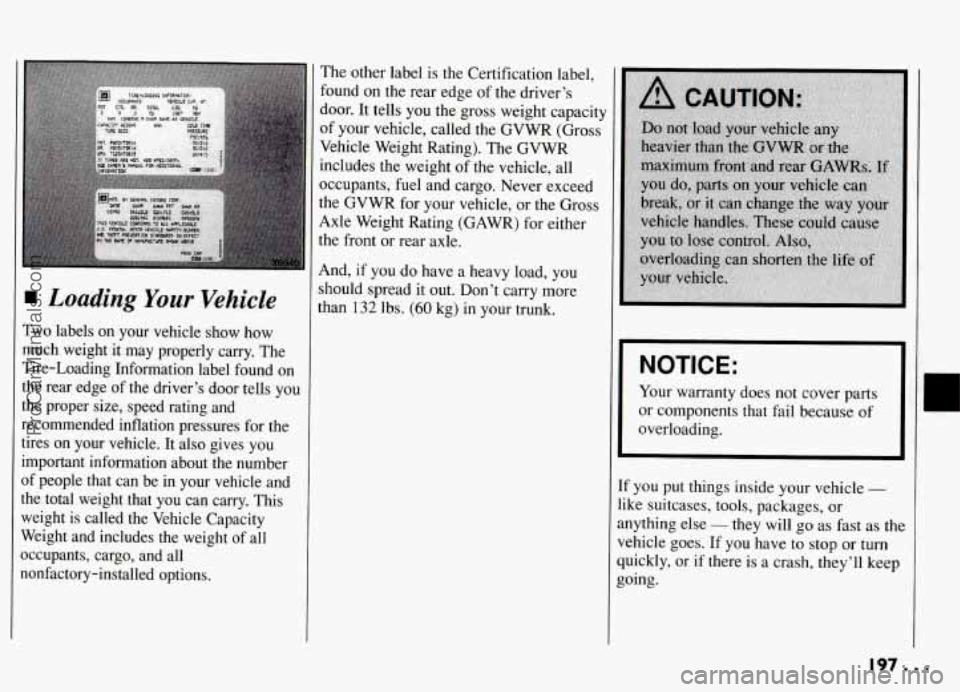
I Loading Your Vehicle
Two labels on your vehicle show how
much weight it may properly carry. The
Tire-Loading Information label found on
the rear edge of the driver’s door tells you
the proper size, speed rating and
recommended inflation pressures for the
tires on your vehicle. It also gives you
important information about the number
af people that can be in your vehicle and
the total weight that you can carry. This
weight is called the Vehicle Capacity
Weight and includes the weight of all
xcupants, cargo, and all
lonfactory-installed options.
The other label is the Certification label,
found on the rear edge of the driver’s
door. It tells you the gross weight capacity
of your vehicle, called the GVWR (Gross
Vehicle Weight Rating). The GVWR
includes the weight of the vehicle, all
occupants, fuel and cargo. Never exceed
the GVWR for your vehicle, or the Gross
Axle Weight Rating (GAWR) for either
the front or rear axle.
And, if you do have a heavy load, you
should spread it out. Don’t carry more
than
132 lbs. (60 kg) in your trunk.
I NOTICE: 1
Your warranty does not cover parts
or components that fail because of
overloading.
[f you put things inside your vehicle -
like suitcases, tools, packages, or
mything else
- they will go as fast as the
Jehicle goes. If you have to stop or turn
quickly, or if there is a crash, they’ll keep
going.
197.. .
ProCarManuals.com
Page 200 of 274

Inflation - Tire Pressure
The Tire-Loading Information label which is on the rear edge
of the driver’s
L
NOTICE: (Continued)
If your tires have too much air
door shows the correct-inflation pressures
for your tires, when they’re cold. “Cold”
means your vehicle has been sitting for at least three hours or driven no more than a
mile.
Don’t let anyone tell you that underinflation
or overinflation is all
right. It’s not. If your tires don’t
have enough air (underinflation)
0 Too much flexing
0 Too much heat
0 Tire overloading
0 Bad wear
0 Bad fuel economy.
I P
C
c
SI
I
,
(oierinflation), you can get:
0 Unusual wear
0 Bad handling
0 Rough ride
Needless damage from road
hazards.
Yhen to Check
lheck your tires once a month or more.
Ion’t forget your compact spare tire. It
ilould be at 60 psi (420 Pa).
How to Check
Use a good quality pocket-type gage to
:heck tire pressure. Simply looking at the
ires will not
tell you the pressure,
:specially if you have radial tires
--
which may look properly inflated even if
[hey’re underinflated.
;.. :.?
[f your tires have valve caps, be sure to
put them back on. They help prevent
leaks by keeping out dirt and moisture.
. . 1. .
,,
ProCarManuals.com
Page 201 of 274
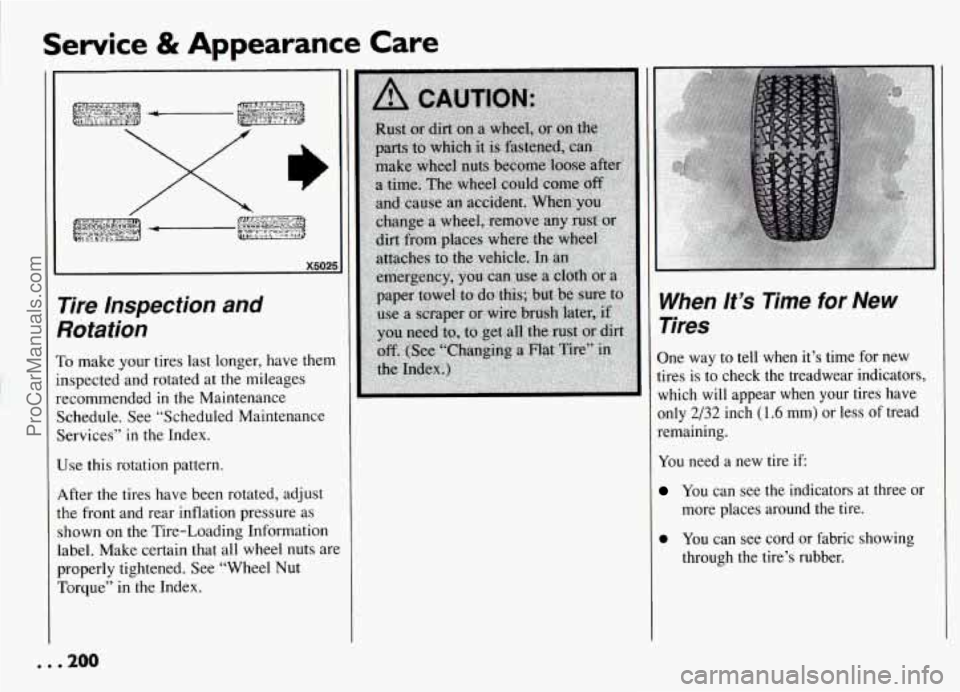
Service & Appearance Care
Tire Inspection and qotation
i’o make ,your tires last longer, have them
nspected and rotated at the mileages
ecommended
in the Maintenance
ichedule. See “Scheduled Maintenance
jervices”
in the Index.
Jse this rotation pattern.
4fter the tires have been rotated, adjust
he front and rear inflation pressure as
;hown on the Tire-Loading Information
abel. Make certain that all wheel nuts arc
xoperly tightened. See “Wheel Nut
rorque” in the Index.
When It’s Time for New
Tires
One way to tell when it’s time for new
tires is to check the treadwear indicators,
which
will appear when your tires have
only
2/32 inch (1.6 mm) or less of tread
remaining.
You need a new tire if
You can see the indicators at three or
more places around the tire.
0 You can see cord or fabric showing
through the tire’s rubber.
ProCarManuals.com